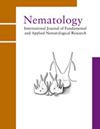商业水培系统水培基质中线虫群落的探索
IF 1.2
4区 生物学
Q2 ZOOLOGY
引用次数: 0
摘要
线虫在土壤中发挥着重要的生态系统服务,在传统农业中得到了很好的研究,但它们在新的无土壤粮食生产系统中的作用尚未得到研究。我们从商业水培系统的水培培养基床内的基质中确定了线虫组合。研究了三种基质:椰壳、堆肥和轻质膨胀粘土骨料(LECA),并通过传统形态学分析确定了线虫的组合。所有基质都适合线虫生长,但与传统堆肥相比丰度较低。来自水培培养基床内的堆肥具有与系统外堆肥相似的成熟度指数(MI)的线虫组合,并且两种堆肥都容纳了具有高比例杀菌剂、高富集度和无结构的线虫。LECA经常受到干扰,几乎没有有机物堆积,类似于堆肥——高度富集,缺乏结构。LECA未受干扰的时间更长,可以积累更多的有机物,与其他基质相比,其组合结构高度结构化,富集程度较低。椰壳内的线虫组合显示出很少的富集,但具有更高的MI,并且比堆肥更有结构。在任何样本中都没有发现有问题的植物寄生线虫。我们首次了解了线虫在水培系统中的作用,并鼓励未来的研究探索这些系统中的线虫如何影响产量和植物健康。本文章由计算机程序翻译,如有差异,请以英文原文为准。
An exploration of nematode assemblages in the hydroponic media beds of a commercial aquaponics system
Nematodes perform important ecosystem services in soils and are well studied in traditional farming, but their role in newer soil-less food production systems is unstudied. We determined the nematode assemblages from substrates within the hydroponic media beds of a commercial aquaponics system. Three substrates were studied: coir, compost and lightweight expanded clay aggregate (LECA), with the nematode assemblages ascertained via traditional morphological analysis. All substrates were suitable for nematodes but abundance was lower compared with traditional compost. Compost from within the hydroponic media beds had nematode assemblages with similar maturity indices (MI) to compost external to the system, and both composts housed nematodes with a high proportion of bacterivores, a high degree of enrichment and no structure. LECA that were regularly disturbed and had little organic build up resembled compost – highly enriched and lacking structure. LECA that had been left undisturbed for longer and allowed to accumulate more organic matter had highly structured assemblages and showed less enrichment than the other substrates. Nematode assemblages within the coir showed very little enrichment but had higher MI and were more structured than compost. Problematic plant-parasitic nematodes were not found in any of the samples. We present the first glimpse into the role of nematodes in aquaponics systems and encourage future studies to explore how nematodes in these systems affect yield and plant health.
求助全文
通过发布文献求助,成功后即可免费获取论文全文。
去求助
来源期刊

Nematology
生物-动物学
CiteScore
2.60
自引率
33.30%
发文量
67
审稿时长
3 months
期刊介绍:
Nematology is an international journal for the publication of all aspects of nematological research (with the exception of vertebrate parasitology), from molecular biology to field studies. Papers on nematode parasites of arthropods, and on soil free-living nematodes, and on interactions of these and other organisms, are particularly welcome. Research on fresh water and marine nematodes is also considered when the observations are of more general interest.
Nematology publishes full research papers, short communications, Forum articles (which permit an author to express a view on current or fundamental subjects), perspectives on nematology, and reviews of books and other media.
 求助内容:
求助内容: 应助结果提醒方式:
应助结果提醒方式:


